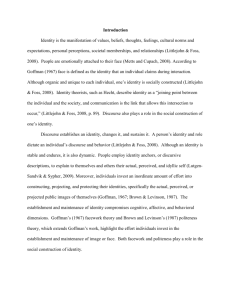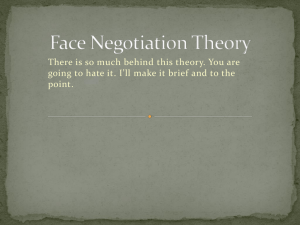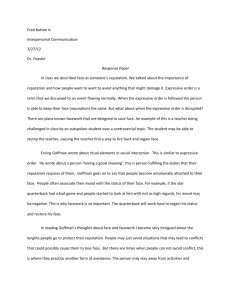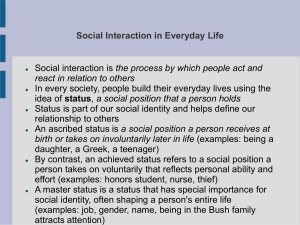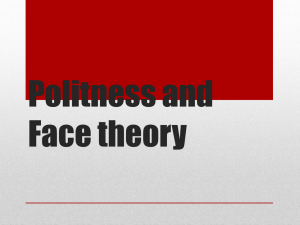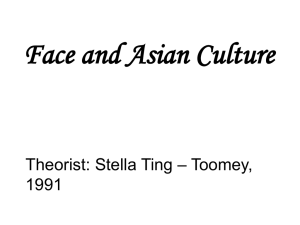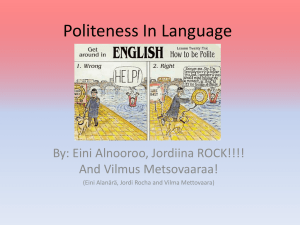Facework politeness 101
advertisement
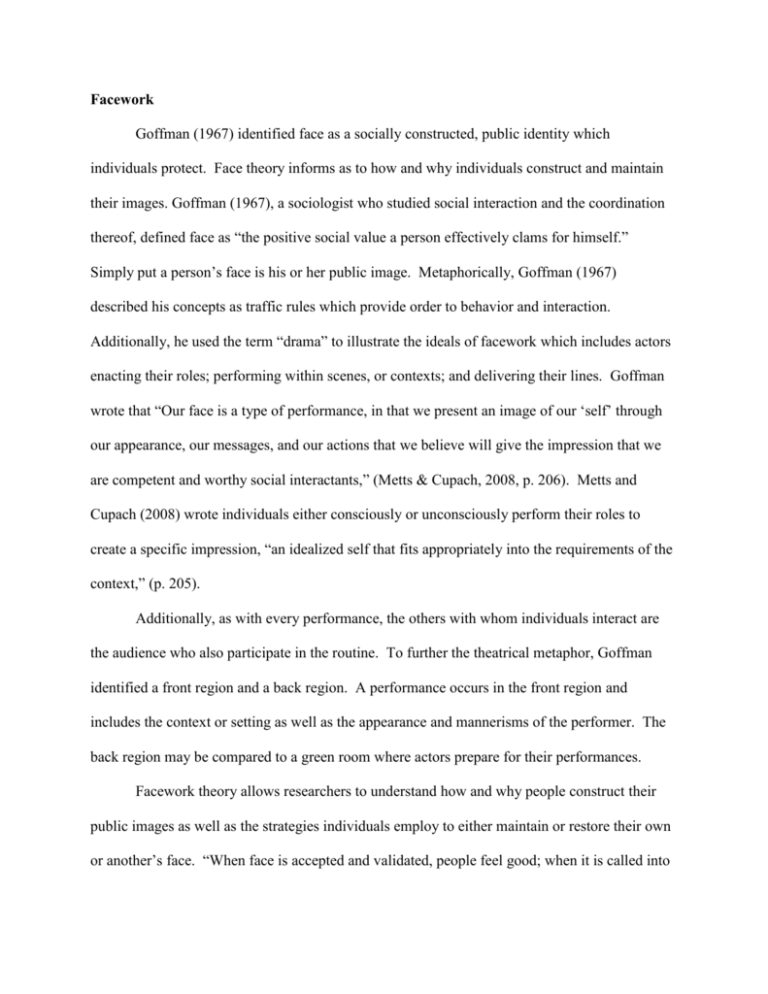
Facework Goffman (1967) identified face as a socially constructed, public identity which individuals protect. Face theory informs as to how and why individuals construct and maintain their images. Goffman (1967), a sociologist who studied social interaction and the coordination thereof, defined face as “the positive social value a person effectively clams for himself.” Simply put a person’s face is his or her public image. Metaphorically, Goffman (1967) described his concepts as traffic rules which provide order to behavior and interaction. Additionally, he used the term “drama” to illustrate the ideals of facework which includes actors enacting their roles; performing within scenes, or contexts; and delivering their lines. Goffman wrote that “Our face is a type of performance, in that we present an image of our ‘self’ through our appearance, our messages, and our actions that we believe will give the impression that we are competent and worthy social interactants,” (Metts & Cupach, 2008, p. 206). Metts and Cupach (2008) wrote individuals either consciously or unconsciously perform their roles to create a specific impression, “an idealized self that fits appropriately into the requirements of the context,” (p. 205). Additionally, as with every performance, the others with whom individuals interact are the audience who also participate in the routine. To further the theatrical metaphor, Goffman identified a front region and a back region. A performance occurs in the front region and includes the context or setting as well as the appearance and mannerisms of the performer. The back region may be compared to a green room where actors prepare for their performances. Facework theory allows researchers to understand how and why people construct their public images as well as the strategies individuals employ to either maintain or restore their own or another’s face. “When face is accepted and validated, people feel good; when it is called into question, they feel bad. Thus, the general rules of ‘self-respect’ and ‘considerateness’ lead us to act in ways that maintain our own face and to cooperate in the maintenance of others,” (Metts & Cupach, 2008, p. 206). If a face threatening situation occurs interactants may lose face. Goffman identified two types of loosing face. The first in being in “wrong face”, the second is being “out of face.” An individual may be in wrong face when information is disclosed or behavior enacted that is incongruent with a person’s projected public image. Being out of face occurs when an individual cannot maintain an image that is either expected or required in a given situation. People engage in facework and communicate and behave in ways to either avoid face dissonance or restore their public image. Goldsmith (2000) studied explored patterns of advice solicitation using ethnographic field notes and perceived face threats associated with advice solicitation. This scholar wrote that understanding how and knowing when individuals’ face is threatened informs as to which messages, including form and content, are more appropriate and effective in varying contexts. Additionally, Goldsmith suggested that face considerations may differ in diverse socio-cultural groups. Facework includes myriad strategies, including verbal and nonverbal messages. Excuses, justifications, remediation, humor, avoidance, and aggressive actions may be incorporated into face-saving methods as well (Metts and Cupach, 2008). Face is socially constructed; therefore, the strategy employed will be dictated by the context. These potential situations of face dissonance propel individuals to communicate and behave in ways that do not threaten their public image. However, if these situations do occur people engage in facework. Metts and Cupach (2008) referenced the work of Cavanagh, Dobash, Dobash, & Lewis (2001) who studied the remedial face-work of men who behaved violently toward their significant female others. Several of the strategies these perpetrators employed were denial, shifting blame, minimization, and reduced competence. Additionally some of the men apologies, cried, offered gifts, or vowed not to repeat the behavior. Brown and Levinson (1987) extended Goffman’s facework theory, positing that politeness is one way people protect and maintain their face as well as that of others. This concept will be further explicated below. Politeness Politeness can be used to predict patterns and interpretations of language use in specific contexts (Goldsmith, 2008). Additionally, politeness informs how and why messages are created and interpreted. Politeness creates an impression of the speaker, the hearer, the action and the relationship, according to Metts and Cupach (20098). “Effective communication entails choosing the right amount of politeness for the situation,” (Goldsmith, p. 260). Not employing enough politeness can be interpreted as being rude. Being too polite may compromise understanding of a person’s message or behavior. According to Goldsmith, Brown and Levinson (1987) face is defined as “the public self-image that every member wants to claim…” (p. 256). Their assumptions are congruent with Goffman, (1967) that face is desired, socially constructed; public; and claimed. Therefore, face can be lost, saved, or sustained during interactions. In the abstraction of Goffman’s original theory, Brown and Levinson identify both positive and negative face. Positive face centers around a person’s desire to be approved of and accepted by those with whom he or she is interacting. Negative face refers to an individual’s desire to be autonomous and free from restraint. Individuals find themselves in positions where their identity is challenged; this is referred to as a face threat. Specifically, face-threatening actions (FTA) are verbal or nonverbal communiqués or behaviors which potentially or actually compromise a person’s public image. According to politeness theory’s original scholars, five strategies are possible in the wake of FTAs. The first is “bald on record”, which allows an interactant to honestly act or react, without tact or diplomacy. Positive face redress, is the second politeness approach; it capitalizes on any existing relationship and commonalities between the interactants. Negative face redress employs respect to mitigate face threats. The fourth approach is referred to as between the lines in that it implies a verbal or nonverbal face-saving strategy. Finally, not making any statement in light of an FTA is the fifth approach. The strategy ultimately employed is dictated by the interactive context. This situational determinant is defined by three features: power, distance, and rank. Power relates to a relational hierarchy in which one can impose control or marginalization on another. Distance refers to the closeness and similarity of the interactants. Rank is culturally defined and refers to actual or perceived risk involved in enacting an FTA. The aggregate of these factors is known as the weight, or degree of face threat. A higher degree of threat elicits an more polite approach, whereas a situation which includes less weight prompts a less polite strategy. Harris (2003) explored politeness and power in three institutional contexts as well as how discourse practices and institutional discourse practices are interconnected. This scholar’s research evidenced that “…politeness theory provides a useful alternative framework for interpreting institutional linguistic behavior and defining institutional norms,” (Harris, p. 31).
